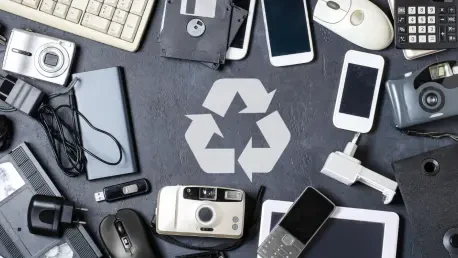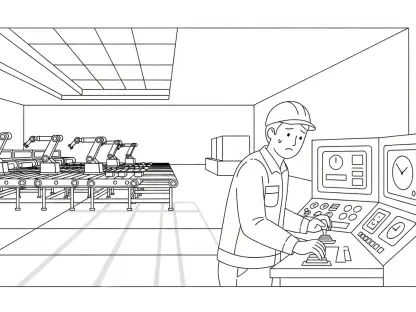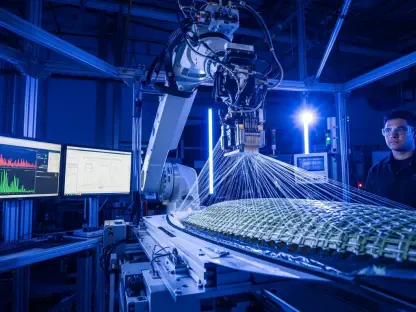Amidst rapid technological advancements, the recycling of electronic waste has become a pressing issue, with current methods failing to efficiently recover crucial materials. In the United States alone, millions of tons of electronic waste are generated annually, yet only a fraction is recycled, leaving critical materials untapped. Even with modern techniques, traditional recycling centers often overlook the immense value of lesser-known materials like gallium, indium, and tantalum. These elements are pivotal for future technologies but remain out of reach due to the costliness and hazards of current recovery processes.
A significant portion of e-waste recycling involves shipping discarded electronics overseas, where unsafe practices, such as burning materials for metal extraction, threaten both environmental sustainability and human health. This situation calls for a revolutionary approach to e-waste recycling, capable of transforming the industry by overcoming existing inefficiencies and risks. Researchers at West Virginia University have proposed an innovative solution using microwave technology, which promises safer and more economical recovery of critical minerals, thus addressing major environmental and economic concerns.
The Inefficiencies of Current Methods
Current recycling processes rely predominantly on mechanical means, which separate basic materials like steel and aluminum but typically fail to recover more valuable elements. Despite restrictions in the United States governing how e-waste is handled, many recycling centers lack advanced technologies to efficiently extract precious materials. Gallium, indium, and tantalum, among others, are often omitted from these processes due to their complex extraction requirements, which are not economically viable with existing methods.
While the Environmental Protection Agency has enforced regulations to curb unsafe recycling methods, a significant portion of North America’s e-waste is shipped to foreign markets where environmental standards may be less stringent. Here, workers often resort to detrimental practices, such as using harmful chemicals or burning waste, to retrieve metals. These methods risk both environmental degradation and health issues for those involved, signaling an urgent need for advancement in recycling technologies that preserve both human safety and ecological balance.
Microwave Technology: A Safer Alternative
Microwave technology, as researched by West Virginia University, presents a groundbreaking alternative to traditional recycling methods by selectively heating specific components within e-waste. This method circumvents the use of toxic chemicals, significantly diminishing health and environmental risks. By leveraging the properties of carbon within e-waste, which absorbs microwave radiation more rapidly than other elements, this process facilitates the recovery of minerals that are typically lost in conventional methods.
This innovation demonstrates tremendous potential in retrieving minerals essential for modern technology, highlighting the importance of elements such as indium tin oxide, crucial for touchscreen displays, gallium for LED light emission, and tantalum for capacitors. Recognizing these materials as critical to upholding national technological capabilities, microwave-assisted extraction is positioned as a central component in the shift toward environmentally sound practices in e-waste management. Challenging traditional processes, it offers a scalable and sustainable solution to known inefficiencies and hazards, ensuring material recovery with minimal environmental impact.
Economic Considerations of Critical Materials
The global dependency on a limited number of countries for sourcing these critical materials, particularly China, introduces vulnerabilities due to potential geopolitical tensions and trade disputes. The U.S. reliance on imported materials for its technology sector is increasingly risky, underscored by escalating prices. For instance, gallium commands a high market price, up to 50 times that of commonplace metals like copper. This price disparity highlights both the economic challenge in recovering these materials and the immense value they bring when efficiently extracted.
Addressing this economic aspect, the microwave technology method devised by West Virginia University researchers can economically recover precious materials, offering a way to mitigate shortages and support domestic technology manufacturing. By transforming the landscape of e-waste recycling, this method doesn’t just alleviate environmental concerns but also presents significant monetary incentives. As recycling processes become more adept and financially feasible, there emerges a clear opportunity for the U.S. to disentangle its economic reliance on foreign material supply chains, subsequently empowering its technological industry.
Potential to Revolutionize Recycling Practices
West Virginia University’s research has already exhibited promising results in laboratory tests, recovering up to 80% of gallium, indium, and tantalum from e-waste with impressive purity rates between 95% and 97%. These outcomes suggest that integrating microwave technology into existing recycling operations could substantially enhance their productivity while safeguarding the environment. Further development aims to scale up this innovative approach through pilot projects that will test its viability across varied e-waste components, including smartphones, LED light parts, and data center server cards.
This initiative has the potential to reshape national recycling capabilities, integrating critical materials sourcing practices essential for technological progress and national security. With involvement from the Defense Department’s Advanced Research Projects Agency, such measures align with goals to enhance domestic resource security, emphasizing their importance for applications in defense technologies, such as radar systems and nuclear reactors. Through these efforts, microwave technology could redefine not just recycling efficiency but the very foundation of e-waste management.
Beyond Technology: Legislative and Economic Drivers
Advancing e-waste recycling practices transcends technological innovation, requiring also legislative action and economic incentives to effect meaningful change. Measures such as mandating electronics companies to responsibly recycle their products and closing legal loopholes that allow e-waste exportation could significantly nourish domestic recycling infrastructure. Nonetheless, the drive for change seems most potent through economic incentives.
As innovations like microwave technology improve and become accessible, monetary motivations will increasingly catalyze transformations within the industry. Efficient material recovery methods present lucrative opportunities, potentially igniting substantial shifts toward a more sustainable recycling landscape. In addressing the critical material shortages faced by the U.S., economic interests will likely play a pivotal role in facilitating necessary advances and reconfiguring recycling practices to meet contemporary demands.
Paving the Way for an E-Waste Recycling Revolution
Rapid advancements in technology have made electronic waste recycling a vital issue, yet current methods aren’t efficiently recovering key materials. In the U.S., millions of tons of e-waste are created yearly, but only a small percentage is recycled, leaving essential materials like gallium, indium, and tantalum untapped. Though critical for future technologies, these lesser-known elements remain largely out of reach due to expensive and hazardous recovery processes. Much of e-waste recycling involves shipping discarded electronics overseas, where unsafe practices like burning materials for metal extraction pose risks to environmental sustainability and human health. Addressing these challenges requires a revolutionary approach to e-waste recycling. Researchers at West Virginia University have proposed a groundbreaking solution using microwave technology. This innovation promises a safer and more cost-effective way to recover essential minerals, addressing significant environmental and economic issues and potentially transforming the recycling industry.









